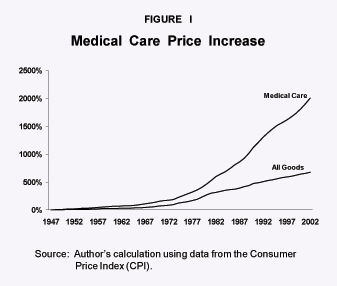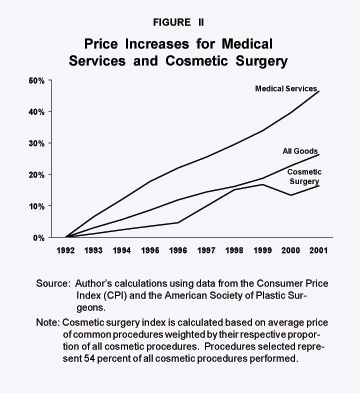Prices for medical services have been rising faster than prices of other goods and services for as long as anyone can remember. But not all health care prices are rising. Although health care inflation is robust for those services paid by third-party insurance, prices are rising only moderately for services patients buy directly. For example, the real (inflation-adjusted) price of cosmetic surgery fell over the past decade – despite a huge increase in demand and considerable innovation.
Health Care Costs Rise When Others Pay.
A primary reason why health care costs are soaring is that most of the time when we enter the medical marketplace as patients, we are spending someone else's money. Economic studies and common sense confirm that we are less likely to be prudent, careful shoppers if someone else is paying the bill. When we are paying our own medical bills, we are conservative consumers. The increase in spending has occurred because someone else is paying the bill.
The Extent of Third-Party Payment of Medical Bills. Although polls show that many people fear they will not be able to pay their medical bills from their own resources, the reality is that most of us pay for only a small portion of our medical care:
Every time we consume $1 worth of hospital care, we pay only about three cents out of pocket; 97 cents is paid by a third party (employer, insurance company or government).
Every time we consume $1 worth of physician services, we pay less than 15 cents out of pocket.
For the health care system as a whole, every time we consume $1 in services, we pay only 18 cents out of pocket.
Thus we have an incentive to consume hospital services until they are worth to us, on the average, only three cents on the dollar. We have an incentive to consume physicians' services until they are worth only 15 cents on the dollar. And for the health care system as a whole, our incentive is to utilize everything modern medicine offers until the value to us is only 18 cents out of the last dollar spent.
Medical Inflation.
Prior to the advent of Medicare and Medicaid in 1965, health care spending never exceeded 6 percent of gross domestic product. Today it is 14 percent. These two government programs unleashed a torrent of new spending and led to rising health care prices. See Figure 1 Even the federal government estimates that each additional $1 of Medicare spending yields only 35 cents worth of additional care. The other 65 cents buys higher prices. The private sector shift to more third-party payment has exacerbated this trend.
Cosmetic Surgery Prices.
Cosmetic surgery is one of the few types of medical care for which consumers pay almost exclusively out of pocket. Even so, the demand for cosmetic surgery exploded in recent years. Of the 6.6 million cosmetic procedures performed in 2002, 1.6 million were surgical procedures, nearly four times the number performed in 1992. Despite the quadrupling of the number of surgeries, cosmetic surgeons' fees remained relatively stable. The average increase in prices for medical services from 1992 through 2001 was 47 percent. See Figure 2 The increase in the price of all goods, as measured by the consumer price index (CPI), was 26 percent. Cosmetic surgery prices went up about 16 percent. Thus while the price of medical care generally rose almost twice as fast as the CPI, the price of cosmetic surgery went up less than two-thirds as much. Put another way, while the real price of general health care rose, the real price of cosmetic medicine fell.
Keeping Costs Down.
What explains this price stability? One reason is patient behavior. When patients pay with their own money, they have an incentive to be savvy consumers. A second reason is supply. As more people demanded the procedures, more surgeons began to provide them. Since almost any licensed medical doctor may obtain training and perform cosmetic procedures, entry into the field is relatively easy. A third reason is efficiency. Many providers have operating facilities located in their offices, a less expensive alternative to outpatient surgery at a hospital. Surgeons generally adjust their fees to stay competitive and usually quote patients a package price. Absent are the gatekeepers, prior authorization and large medical office billing staffs needed when third-party insurance pays the fees. A fourth reason is the emergence of substitute products. (See below.)
Fostering Competition.
Web sites help create a competitive market for cosmetic procedures. One, www.Bidforsurgery.com, is a reverse auction site that works much like eBay. Physicians submit competitive bids to perform procedures. The potential patient compares bids and quality indicators – information on residency, education, board certifications, etc. Patients can select a bid from among those physicians bidding or reject them all. If the patient does choose one of the bids, he or she gets a free consultation with the selected physician before making a final commitment.
Cosmetic Surgery and Innovation.
A common perception is that innovation results in health care inflation. But in cosmetic surgery, innovation often lowers the cost. Take facelifts, for example. Surgical fees for facelifts increased only 20 percent between 1992 and 2001 (which in real terms is a price reduction), according to data from the American Society of Plastic Surgeons.
Holding the cost of facelift surgery in check were cheaper procedures designed to reduce the appearance of aging. Laser resurfacing ($2,232) can replace or delay surgical facelifts in some patients. Retin-A treatments ($124 per visit), botox injections ($388), collagen injections ($333), chemical peels ($516), dermabrasion ($1,254) and fat injection ($1,053) are other facelift alternatives. These less invasive (and less expensive) procedures may be attractive, compared to a facelift costing $5,007 in surgeons' fees alone.
Cosmetic surgeons also have incentives to find new products to meet customer needs. Laser hair removal, for example, is now common.
Conclusion.
The contrast between cosmetic surgery and other medical services is important. One sector has a competitive marketplace and stable prices. The other does not.
Devon Herrick is research manager at the National Center for Policy Analysis.